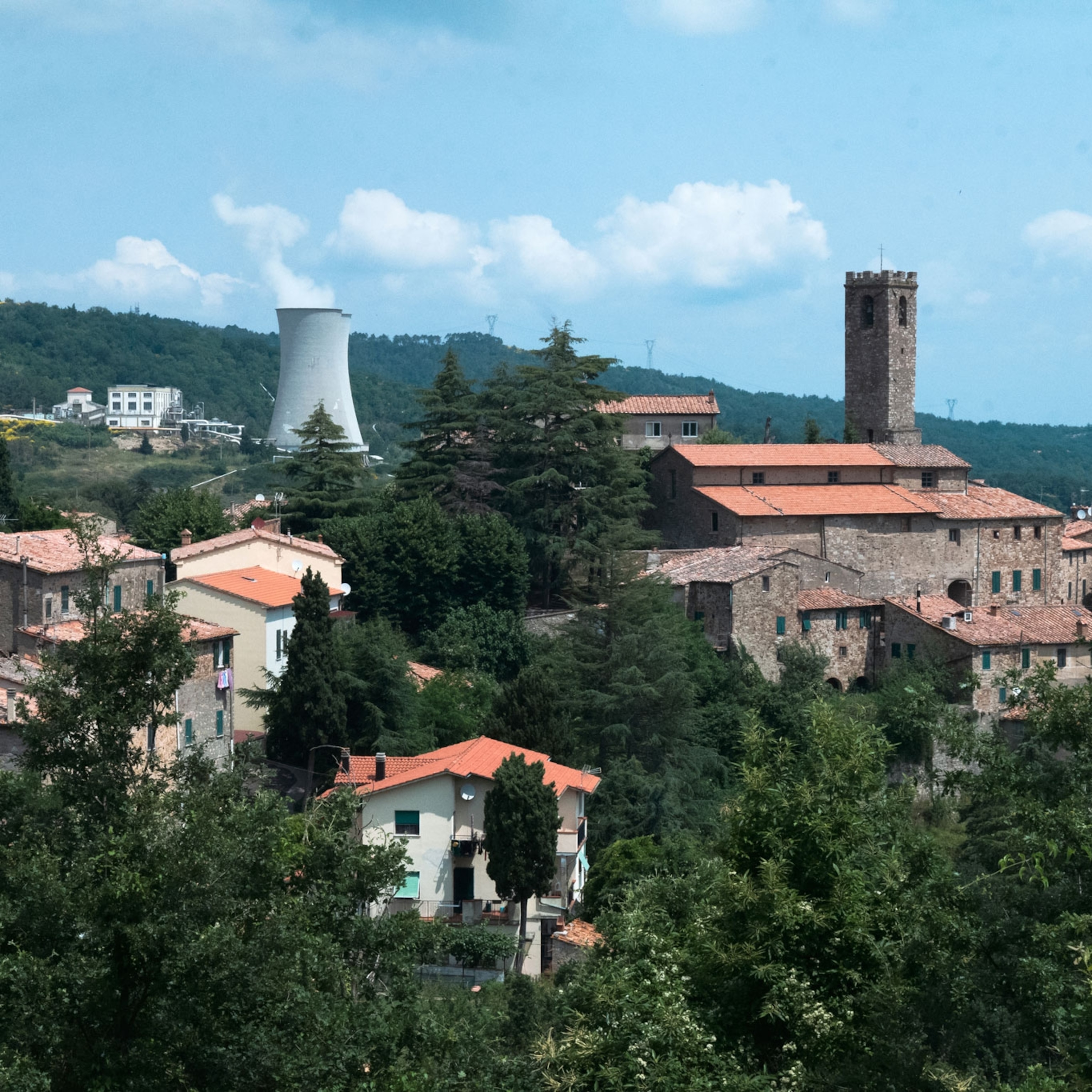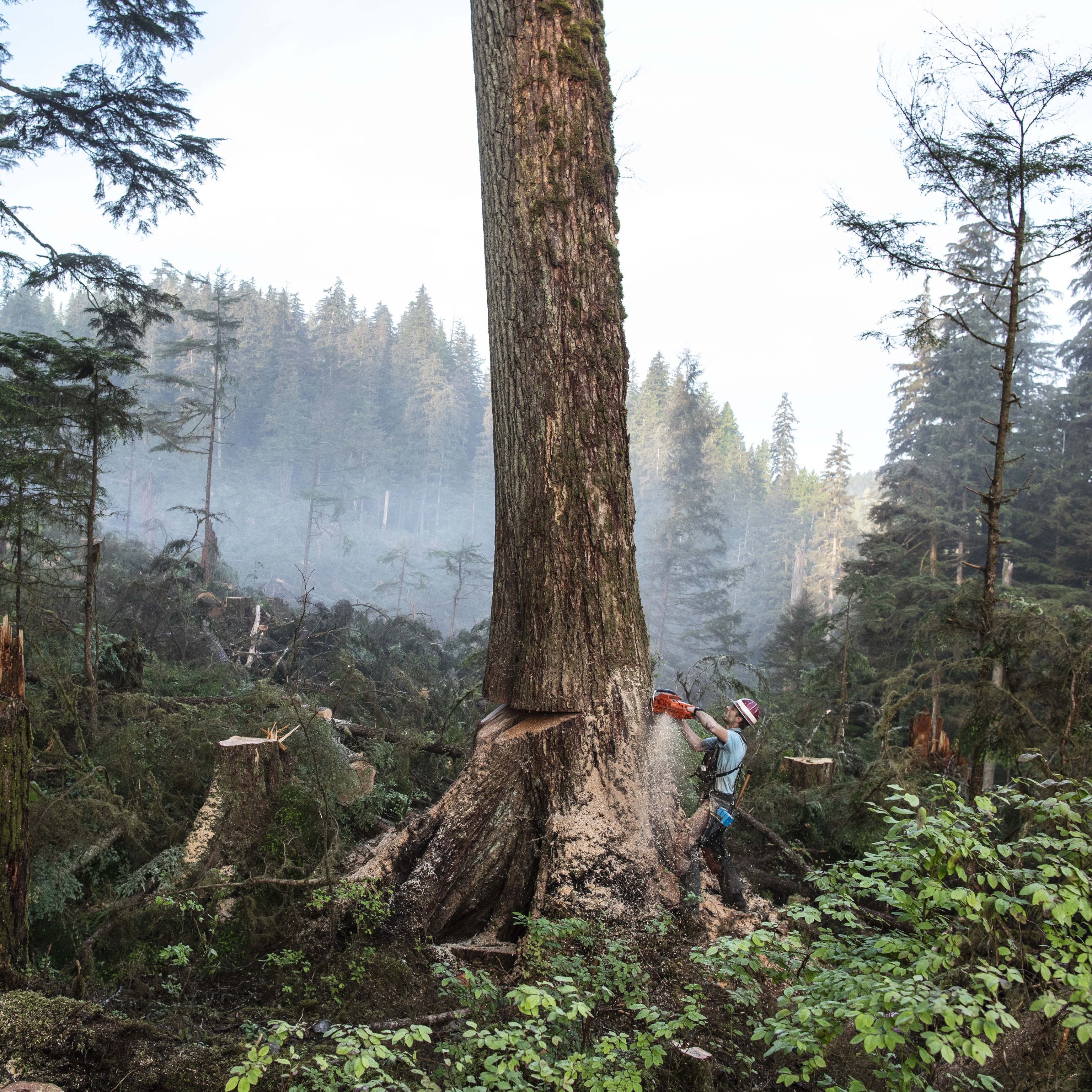
Europe burns a controversial ‘renewable’ energy source: trees from the U.S.
As world leaders pledge more action on climate change, one so-called solution—burning trees for electricity—could undermine progress.
North Carolina’s Cape Fear River is dotted with industrial facilities, cranes, storage containers, large ships, and old cypress trees with large roots anchored in the water. Near the mouth of the river, two white domes, each capable of holding 45,000 metric tons of wood, tower over the river bank.
It’s here, where the river meets the sea, that wood pellets stored in the domes are packed onto a ship and transported across the Atlantic, to be burned in power plants that generate electricity.
Millions of tons of wood pellets, each the length of a fingernail and width of a straw, are replacing coal in Europe. Billed as a clean fuel that helps countries meet their renewable energy targets, these so-called woody biofuels are at the center of a rapidly growing industry valued at $50 billion globally in 2020.
The logic behind considering them a renewable source of energy, like solar or wind, is simple: As long as forests are allowed to regrow after trees are cut and burned, the carbon dioxide released by burning will be absorbed by the growing trees. It’s a net-zero transaction, proponents say—and the European Union and other governments have accepted the argument. Wood is considered a zero-emissions fuel.
At the smokestack, burning wood actually emits more greenhouse gas emissions than coal. But critics of the biomass industry say a complicated global system for counting emissions has created a loophole: Countries are not required to count the carbon emissions emitted by wood-fired power plants. That allows woody biofuels to flourish as a climate solution nevertheless.
Early this year, 500 scientists sent a letter to world leaders warning that logging forests for bioenergy would undermine the fight against climate change. A 2018 study led by one of the signatories of the letter, John Sterman of MIT, supports that view; it says cutting down trees to burn them would be worse for climate over the next few decades.
“It’s the opposite of what we should be doing,” says Andy Wood, director of the North Carolina-based Coastal Plain Conservation Group. “We’re hoping it will be addressed at Glasgow.”
The United Kingdom, which is hosting the COP26 climate conference in Glasgow, Scotland through November 12, is the world’s largest consumers of wood pellets. The Drax Power Station in Yorkshire, once the largest coal plant in the U.K., now runs mostly on wood pellets—including, in 2019, some five million tons imported from the U.S. Drax itself has become a major player in the international wood pellet market.
Environmental advocates fear other countries will soon follow the U.K.’s lead; indeed, Japan and South Korea are now also importing wood pellets, including from a Drax subsidiary. Provisions in two U.S. bills—the recently passed infrastructure bill and a soon-to-be-voted-on reconciliation bill—promote the use of biomass energy. More than 100 scientists are encouraging President Joe Biden to remove these provisions.
“It’s much easier to convert a dirty coal plant to burn another fuel than to do something transformative like create solar and wind,” says Sasha Stashwick, a biomass policy expert at the Natural Resources Defense Council.
Peg Putt, an advocate at the Environmental Paper Network, an international organization dedicated to making the paper and pulp industries greener, says the issue of how carbon emissions from biomass burning should be counted is too often ignored. She and other experts don’t really expect much of a discussion at COP26.
“We need to crack through the notion that biomass accounting is some technical thing that most people can't understand and that therefore is best left to the technical experts,” says Putt. At climate conferences, she says, “As soon as you start trying to talk to the negotiators for the different parties, their eyes glaze over.”

The problem with wood
Yet it’s actually not too complicated to understand why scientists and environmentalists say burning wood is not a simple net-zero exercise.
The most fundamental problem is one of timing. The biomass industry argues that emissions caused by cutting and burning trees are offset by the trees that grow in their place—but trees take a long time to grow.
“There is a carbon debt that occurs when you harvest trees, and it still takes young trees a long time to recover the carbon stock that was lost,” says Rich Birdsey, an expert on forest carbon budgets at the Woodwell Climate Research Center.
“It’s like you draw down your checkbook and you create a debt in your account,” says Sami Yassa, a scientist at the Natural Resources Defense Council. “That’s what’s happening in the atmosphere. In order to repay that debt with forest regrowth, the basic math tells you it’s going to take decades.”
The Sterman study estimated that the carbon “payback time” for wood-burning ranged from 44 to 104 years, depending on the type of forest. In the meantime, it said, power plants that burn wood are adding CO2 to the atmosphere, just as if they were burning coal.
And in the meantime, ice continues to melt, seas continue to rise, people continue to be displaced by extreme weather—the scientific consensus, repeated again and again at COP26, is that the world can’t wait to dramatically reduce its emissions.
What’s more, there are at least two reasons why cutting down trees today to burn in power plants could add even more carbon to the atmosphere than burning coal. First, the trees immediately stop doing what living trees do—they stop removing carbon from the atmosphere. Nothing like that happens when you mine coal.
Second, wood burns less efficiently than coal or gas. Per kilowatt-hour (kWH) of electricity generated, it emits one and a half times the carbon dioxide of coal and three times that of natural gas.
In 2019, according to a recent report by the policy research group Chatham House, U.K. power plants burning wood pellets emitted as much as 16 million metric tons of carbon dioxide, roughly equal to what comes out of six to seven million car tailpipes. If those emissions had been counted, it would have added as much as 27 percent to the electricity sector’s emissions—and up to 3.6 percent to the U.K.’s total greenhouse gas emissions for that year.
But like other governments, the U.K. does not count CO2 emissions from wood burning.

A dangerous loophole
In the mid-1990s, when scientists were devising a scheme for counting global emissions under the UN Framework Convention on Climate Change (UNFCCC)—the treaty that gave rise to the annual COP meetings— they decided that emissions would be counted where they were created, at the smokestack or tailpipe. So if Europe imported oil from Saudi Arabia, Europe would be responsible for the emissions created from burning it.
But trees are different from oil.
“They turned to land use and said, ‘When you cut down a tree, it’s hard to track what happens to the carbon,” says Tim Searchinger, an expert on climate change policy at Princeton University and a senior fellow at the World Resources Institute. “Some [carbon is] lost to the forest. Some to a paper mill. Some when the paper is thrown into a landfill. So we’re going to have a different rule in the land-use sector that says you count the carbon when the tree is harvested.’”
When national governments began trying to regulate and limit carbon emissions under the 1997 Kyoto Protocol, they incorporated what Searchinger calls a “critical accounting error”: They exempted all bioenergy from emissions limits at the smokestack without placing limits on emissions from land use. In effect, they decided that all bioenergy was carbon-neutral, even if it came from cutting down a forest.
“A rule designed to avoid counting the carbon from harvesting and burning trees twice became a rule that never counted this carbon at all,” says Searchinger.
International policymakers haven’t just failed to limit biomass burning, Searchinger and other opponents say—they’ve incentivized it.
In 2005, when Europe created its emissions trading system, capping emissions from power plants and factories and forcing them to purchase emissions allowances, it exempted bioenergy. A power plant burning coal could start burning wood pellets, and on paper its emissions—and thus its costs under the EU scheme—would appear to have plummeted.
“The whole wood pellet industry is basically being driven by this,” says Searchinger.
In 2009, Searchinger and his colleagues published a study outlining this reporting error. In response, he says, “everyone ignored it.”
By that same year, the EU was issuing more than a billion U.S. dollars’ worth of subsidies to biomass companies that could help countries meet their clean energy targets, says the NRDC’s Yassa. Soon there was not enough wood in Europe to meet demand.
“You had this giant sucking sound across the Atlantic,” Yassa says, as the European market suddenly created lucrative incentives to cut down trees in the U.S.
The U.S. EPA reports emissions resulting from forest loss to the UNFCCC in its annual greenhouse gas inventory. But since there is no tax or other limit placed on such emissions, it doesn’t really matter. Globally, few countries have tried to place limits on land-use emissions.
“The mere fact that the U.S. reports more emissions doesn’t stop Europe from encouraging [the biomass industry], claiming to be reducing emissions even while the real effect is to increase them,” says Searchinger.

Local as well as global impact
On the ground, Scot Quaranda, from environmental advocacy group Dogwood Alliance, saw immediate threats to North Carolina’s forests as soon as European demand for wood pellets began to surge.
“Honestly, it was pretty devastating,” Quaranda says.
Maryland-based Enviva, the world’s largest biomass producer, ships wood pellets from southeastern states in the U.S. to the U.K. The company says it promotes healthy forests by selectively logging certain trees to give others more room to grow, and that it uses wood that has little to no value.
But environmentalists say that description does not tell the full story. The NRDC, Dogwood Alliance, and the Southern Environmental Law Center published a report in 2019 that exposed destructive logging practices by Enviva, accusing the company of cutting wetland forests throughout the Southeast—forests that are critical for biodiversity.
In an emailed statement, Enviva called the report “inaccurate and misleading,” pointing out that biomass collected for wood pellet production from Enviva and other producers represents just 3 percent of wood products extracted from Southeast forests every year.
While nearly a third of Enviva’s wood is sourced from residues or trees thinned from forests, the company notes that 69 percent of it comes from clear-cutting what it describes as low-value wood.
“When done properly, and in line with forestry Best Management Practices for protecting soil and water quality, clear-cutting creates good conditions for replanting, which encourages landowners to continue keeping that land in forest cover,” says an Enviva spokesperson.
There is evidence of property owners in the Southeast being encouraged by demand for wood pellets to plant trees. According to Brent Sohngen, an expert on environmental economics at Ohio State University, that points to a way in which wood-burning could still turn out to have a climate benefit—at least in an ideal world.
In 2017, Sohngen and his colleagues published a study showing that a rising price on carbon could drive property owners to expand forested land dramatically, if they were compensated for the carbon pulled out of the atmosphere and stored in their trees. Within a few decades, wood-burning for electricity could kick in, without damaging climate—because its carbon debt would have been paid in advance by the forest expansion.
The market for wood pellets, combined with the carbon price, might then drive a further expansion of forests.
“Ultimately there’s more carbon in forests,” Sohngen says. In that scenario, burning wood is indeed a better alternative than burning coal.
Acknowledging this debate, Sohngen published additional research in 2020 arguing that growing demand for forest biomass would lead to a greater supply of trees, and—if these forests were properly managed—would increase carbon sequestration.
An emerging industry takes hold in the south
None of the trees sourced by Enviva come from land the company owns. Instead, it relies on small landowners like Charlie King, owner of 60-acre Stone Mountain Farm just north of Fayetteville, North Carolina.
In 2014, a plot of trees on King’s property became infested with Ips beetles, which burrow into pine trees and kill them. By 2019, he realized his trees couldn’t be saved. With no other market for infested wood, he called Enviva.
“The service they provide can’t be found anywhere else,” says King. With the money he made selling his timber, he has planted new trees that will grow in their place.
This relationship is Enviva seen in its best light, and King was featured in the company’s 2020 sustainability report as an example of how Enviva helps local communities.
Helping landowners retain ownership of their forests is one way the industry says it’s promoting sustainability. Better to log some private forests than to turn them all into neighborhood subdivisions and parking lots, proponents say.
Yet for some, the wood pellet industry’s growing presence has made life worse.
Sherri White-Williamson is the environmental justice policy director at the North Carolina Conservation Network. She says the heavily industrialized town of Clinton, where she is based, has been hit hard by Enviva’s wood-pellet processing plant. There’s an unpleasant odor, she says, and residents report the buzz of sawmills at all hours and sawdust covering their homes and streets.
A study published in 2018, showed that pellet facilities were 50 percent more likely to be located in communities where poverty levels are high and at least a quarter of residents are not white.
“You have facilities grinding up trees all day every day, to the point where locals are having to sweep off their roofs, clean up their cars. You’re seeing increased asthma,” says Quaranda of the Dogwood Alliance.
“If there is a specific concern or complaint, we always take it very seriously. We investigate the complaint and take mitigation measures,” says Yana Kravtsova, executive vice president of communications at Enviva. “We live and work in the same communities. If something is going wrong, we hear about it.”
An industry poised for growth
In a 2018 commentary in Nature Communications, Searchinger and his colleagues calculated that to generate just 2 percent more electricity from wood-burning, the world would need to double wood harvests. Environmental advocates fear the wood pellet industry will indeed keep growing if emissions rules aren’t changed.
In the European Union's “Fit for 55” framework for reducing emissions by 55 percent by 2030, biomass energy is still labeled as carbon neutral. But in a report published in 2018, the U.K.’s Committee on Climate Change said biomass energy should be limited. The country has contracts extending subsidies through 2027, but when they end, the committee discouraged further use.
These findings haven’t stopped the industry from betting on growth.
Earlier this week, the EU’s climate policy chief, Frans Timmermans, told reporters that Europe needed to rely on biomass to meet clean energy goals. And just before the climate conference began, Louisiana Governor John Bel Edwards visited the Drax power plant, saying he looked forward to continuing to work with the biomass consumer.
In the U.S. Southeast, from southern Virginia to the Texas Gulf Coast, there are now 23 facilities processing trees into wood pellets that are then exported to Europe. An additional eight have been proposed throughout the same region.








